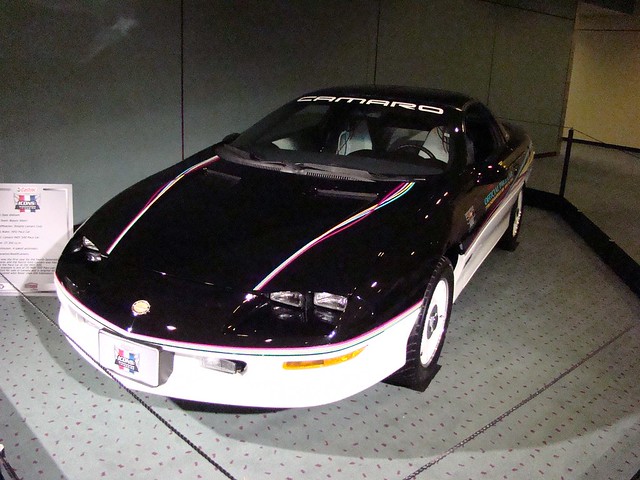 |
| Photo Credit: General Motor/Chevrolet |
This weekend, the Indianapolis 500 will be run for its 100th time. A primary focus around a 500-mile auto race around a historic 2.5-mile race track has resulted in a far amount of traditions. Some of these traditions such as the Fast 9 qualifying shootout and the honorary starter are newer aspects while one of the oldest is the ceremonial pace setter used to lead the field to the green flag. A staple of the Indy 500 since the first race in 1911, the pace car history ranges from a Stoddard-Dayton roadster to a Chevrolet Corvette Z06 used in last year’s event.
This year’s Indianapolis 500 will feature an all-new 2016 Chevrolet Camaro SS trimmed in a special preview of the 50th Anniversary Package. The beautiful Abalone White sixth generation Camaro convertible features a 455-horsepower, 6.2-liter V-8 LT1 engine perfect for maintaining pace lap speed ahead of a 33-car contingent of machines set to run at speed of 230 miles per hour. A tradition within a tradition, the pace car’s driver for the opening warm-up laps is reserved for a dignified member. Speedway founder Carl G. Fisher drove the pace car himself for the first five Indy 500 races but everyone from auto executives, former race car drivers, TV/movie stars and even a pilot who broke the sound barrier have been entrusted with the honours. The 2016 edition of the Indianapolis 500 will be led to the starting line by legendary race car owner Roger Penske. The Chevrolet Camaro possesses a charmed history at the Indianapolis Motor Speedway since its introduction. Serving as the Indy 500 pace car in 1967, it took only two years until the Camaro was commissioned again for the role. Counting the 2016 race, the Chevrolet pony car has served as a pace car on nine occasions. While impressive, the Camaro is second to its brand’s sports car the Chevrolet Corvette who has operated as a pace car 13 times.
Although both Chevrolet vehicles have served well on all their Indy 500 pace car appearances, the honours have lost part of its shine since the bowtie car make has supplied the ceremonial vehicle exclusively since 2002. For much of the Indy 500 events prior to the 21st century, various American brands or manufacturers were provided an opportunity to participate in the race. With exception of the 2003 race led by an SSR, either the Camaro or Corvette was named for the role in the past 15 occasions. Before 2002, it was rare that a single brand would supply a pace car in consecutive years. Even before Chevrolet’s 15-year streak of providing the lead vehicle, General Motors had a stranglehold of pace car duties. The last non-General Motors vehicle to pace the Indianapolis 500 was a Dodge Viper GTS for the 1996 race. The lack of pace car variety in recent years of the Indianapolis 500 does beg us to question whether a high-honour for a production car has lost some of its luster.
 |
| Photo Credit: Chris Nagy |
If the selection for the Indy 500 pace car could be expanded beyond Chevrolet, the spectacle of the race would again be enhanced by buzz similar to when the Dodge Viper RT/10 was used in 1991. With some impressive American branded vehicles developed since 2002, a Dodge Challenger SRT Hellcat and the latest Ford Mustang are two immediately coming to mind as Indy 500 pace cars. If the Indianapolis Motor Speedway would really want to make a huge scene, why not have a Tesla all-electric car serve in the role? The Model S sedan has demonstrated more than ample performance. The last time a vehicle from an auto company not part of the Detroit 3 automakers served as a pace car was 1962 when Studebaker supplied a Lark convertible pace car.
With the way American auto manufacturing is assembled today, could it possibly be time to consider foreign brands built in the United States. Part of the media frenzy behind the 1991 Indy 500 pace car choice was the plan prior to the Viper to run a Dodge Stealth (Japanese built sports car similar to the Mitsubishi 3000GT). The uproar was regarding the fact a non-American produced vehicle was going to lead ‘The Great American Race’. While the Dodge Stealth was blocked, international influence has increased on the construction of pace cars for the Indianapolis 500. The year after the Dodge Stealth fiasco, a Cadillac Allante was chosen wearing a body built in Italy by Pininfarina. It’s also worth noting that every Chevrolet Camaro pace car produced between 1993 and 2014 were actually manufactured in Canada. Today, there are a number of foreign-badged vehicles who have greatly utilized North American production to the point many popular cars are made. Cars like the Acura NSX could have been openly considered as an Indy 500 pace car. Acura isn’t such a radical choice since its parent company Honda has powered winners of the race 10 times.
In a less jarring change, why doesn’t Chevrolet or General Motors pick a vehicle other than the Camaro or Corvette to lead the field at Indianapolis Motor Speedway? Would it be fun if a Chevrolet Volt could be named to the race? Becoming a newsworthy first electrified pace car for the Indy 500, Chevrolet could historically run a pace lap at full speed (roughly 45 miles per hour) on all-electric power. Maybe Chevrolet and the Indianapolis 500 have a reason against introducing too much change. The last vehicle that was not a Corvette or Camaro to pace the Indy 500 was the ill-fated half-sports car, half-truck called the SSR. In the prior year, Oldsmobile’s final contribution to the Indianapolis 500 was the Bravada sport utility vehicle.
Despite the poor reception of those vehicles, it does make sense one of the biggest annual showcases of automotive greatness should reflect changes of the 21st century landscape.

Comments
Post a Comment